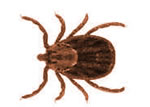Appearance
Ticks vary in color by species. Adult ticks are 1/8- to 5/8-inch long if engorged with blood, nymphal (or immature) ticks are less than 1/16-inch. Common pest ticks include the American dog tick, deer tick, and lone star tick.
Habitat
Often found near wooded and highly vegetated areas. Some tick species require moisture to survive.
Diet
All females and males of most species feed on blood of mammals, birds and reptiles. Ticks require a blood meal at each stage of life in order to grow.
Control
Non-chemical tick control procedures should be implemented along with chemical control methods. Keeping grass and weeds cut short in tick infested areas increases tick desiccation during hot weather, discourages alternative hosts and lessens the amount of plant material which may need a pesticide application to kill ticks. Treatments may be necessary in areas of the yard where ticks are found.
Follow these tips when working or walking in areas potentially inhabited by ticks:
- Wear light-colored long-sleeved shirts and long pants.
- Use tick repellent applied to clothing.
- Carefully inspect your body after leaving infested areas.
- Protect pets by preventing them from going into tick-infested areas or use tick treatment products.
- Inspect pets carefully for ticks after walking them in wooded areas or fields.
To remove a tick embedded in your skin, do not grasp it by the abdomen and pull. Use fine-tipped tweezers to grasp the tick by the head next to the skin and slowly pull backward. Working slowly permits the tick to withdraw its mouthparts so they do not detach and remain in the skin and become infected. Once the tick has been removed, disinfect the bite site with alcohol or apply an antibiotic cream. If Lyme disease is prevalent in your community, save the tick in case it's carrying the germ that may cause this illness and take it to a public health laboratory for analysis.


